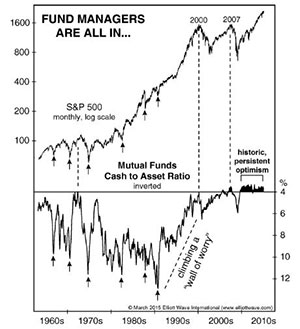
I’ve often been criticized over the past year for not being short-term bullish the stock market when I’m so bullish long-term, expecting Dow 31,000 in the years ahead.
The reason that I am not bullish short- and intermediate-term though is simple: Markets never go straight up.
Indeed, to make big moves up, a market must first make a big move down. That’s how it gains the energy to move higher. Longs are wiped out, shorts get their 15 minutes of fame, and then once a market suddenly crashes, new buyers can come in and shorts can cover their positions, turning the market back around to the upside.
And so it is with the Dow Industrials and other major U.S. stock averages. Until they suddenly crash, shaking out all the longs and giving the shorts their time in the sun, there will be no further major move higher. Period.
If you want more evidence besides all the technical evidence I’ve given you recently from my charts and trading systems, consider the following, courtesy of Bob Prechter’s Elliot Wave Financial Forecast.
I’m talking about bullish sentiment toward stocks. It’s off the charts, and set up to see the markets suddenly shake everyone out.
Take a look at this chart. It shows fund managers mutual fund cash-to-asset ratio, meaning how invested those funds are in stocks, how bullish the fund managers are.
The lower the amount of cash they have (bottom right scale), the more bullish and committed those fund managers are to stocks.
You’ll notice two important points …
1. Cash is highest at market bottoms, and conversely, cash is lowest at or near market tops. Just look at the arrows. And …
2. All major tops in the stock market have occurred when cash was near the 4 percent level, or less.
In fact, according to the analysts at Prechter’s research firm, the only lower reading than we have today at less than 4 percent cash occurred in 1972, just before one of the biggest stock market declines since 1930, at that time.
Refer now to the vertical dashed line at the year 2000. Just before that crash and the tech wreck, mutual fund cash stood at 4 percent as well.
And now refer to the second vertical line in 2007 right at the beginning of the real estate bust. Mutual fund cash dipped below the 4 percent level just before that crash hit.
Now look at where this chart stands today. Mutual fund cash is at historic low levels, meaning optimism is at historic highs. There is simply no way the Dow can take off for my long-term target of 31,000 when optimism is so extreme.
Here’s another chart from Prechter’s firm. It shows how bullish retail investors are right now, and what happens when they are so euphoric as well.
The middle graph shows retail sentiment toward stocks via the money market funds of mutual fund investors as a percentage of S&P 500 market capitalization.
Notice how virtually every time those money market holdings — cash — fell below 5 percent, the market tanked.
Now notice where money market holdings are now, at a historic low of less than 3 percent!
Traders too are overly bullish. Look at the bottom graph in the chart. Bullishness among traders is at a 15-year extreme based on weekly data.
Are retail investors and individual traders super bullish? You bet they are.
Will they experience super-sized gains going forward, or, will they be led to the slaughterhouse next?
My view: The slaughterhouse gates are starting to open!
Soon there will be a sudden, sharp downdraft in stock markets that will scare the bejesus out of nearly everyone.
As to timing it, yes, my timing for an interim top has been off for a while if you want to get picky about it. Price-wise though, my timing hasn’t been off, as all the Dow has done since December 2014 is trade in a range defined by roughly 17,014 on the downside and 18,295 on the upside.
That’s a 1,281 point trading range that has lasted five months. Not the kind of trading range you should be doing much with except waiting for either a breakout above it, or a drop back to test long-term support.
Bottom line: I maintain my view, based on my charts, my system models, cyclical models and more, such as the extreme levels of bullishness that are out there …
That the next BIG MOVE in stocks is going to be DOWN, and DOWN HARD.
Once that unfolds, then, and only then, will stocks be in a position to move to new record highs. My long-term target of Dow 31,000 remains in effect, but unless you hedge, you may have to ride through one heck of a downdraft.
To hedge your stock investments, those that you can’t or don’t want to get out of, consider inverse ETFs on the broad indices. ETFs such as the ProShares UltraPro Short QQQ on the Nasdaq 100 (SQQQ) … ProShares UltraPro Short Dow30 (SDOW) … and the ProShares UltraPro Short S&P 500 (SPXU).
Speculators should consider the same, for your time to make hay is rapidly approaching.
Lastly, there are no changes in any of the other key markets. Gold and silver are bouncing, but their bounces are very weak. Oil’s bounce is weak as well. The dollar’s pullback is very shallow. Deflation still rules!
Best wishes, as always …
Larry














